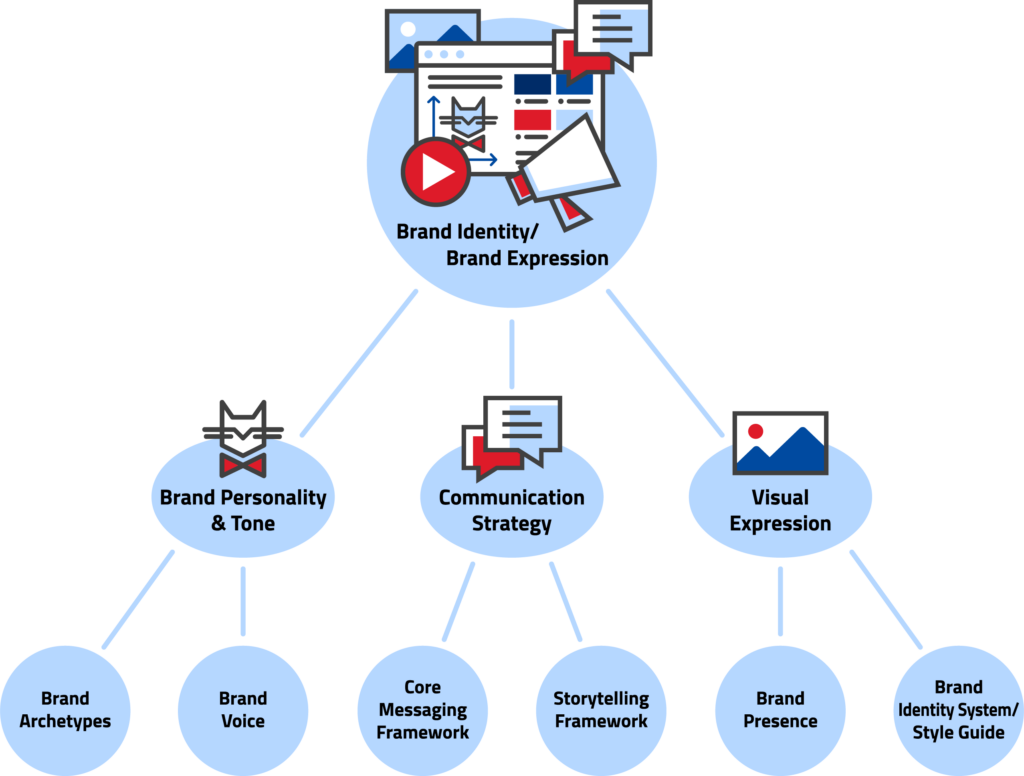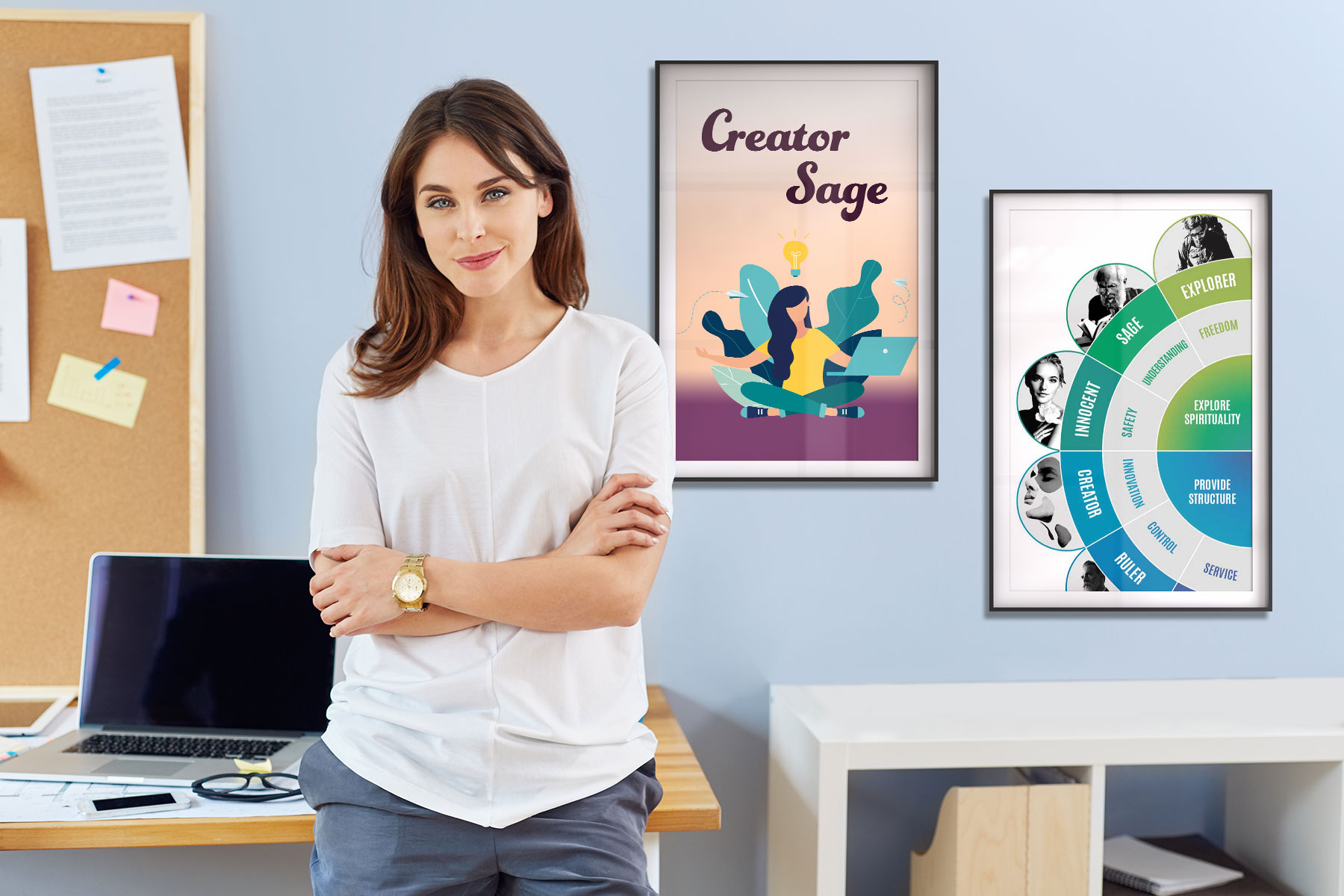Are you familiar with the 16 personality types?
Whether you’ve taken the Myers-Briggs personality test or not, you may be cognizant of whether you tend to be more of an introvert or extrovert or a thinking or feeling type of person.
But did you know there are also a series of 12 archetypes that can be applied to your brand?
Brand archetypes are an excellent way to define your business’ unique personality, establish your communication strategy, solidify visual elements, and guide your overall brand strategy.
In this article, I’ll explain why brand archetypes are essential for your business’ brand and explore each archetype in greater detail.
What Are Brand Archetypes?
Brand archetypes are a series of guidelines that attach your brand to recognizable, known personalities that already resonate with specific audiences.
Each archetype includes core frameworks with a recommended direction for messaging, imagery, color palettes, and more based on universally recognized characteristics.
Brand archetypes provide a foundation for your brand personality; remember that brand personality determines the human traits of your brand and is a subset of your overall brand identity. ![]()

Why Are Brand Archetypes Important for Your Business’ Branding?
Brand archetypes are essential for your brand strategy because they are well-known and proven.
They forge real connections with target audiences because they attach your brand to recognizable stories that people already love and trust.
Popular brands you interact with every day embody a core archetype, whether you know it or not.
That primary archetype dictates how a business presents itself in all communications and interactions, whether through its website content or in its physical storefront.
It establishes consistency every time people interact with a brand by giving them a clear sense of what to expect.
The best part is that these archetypes can be easily applied to your business and used to formulate and implement your brand strategy.
Archetypes reduce the amount of work that you have to do to establish your brand’s personality.
If you’ve never heard of brand archetypes, you might be wondering how they can possibly be well-known.
Think about a well-known movie character, like Yoda from Star Wars.
As Luke Skywalker embarks on his quest to become a Jedi, Yoda provides wisdom, guidance, and advice to help him forge his path.
Whether you’re a Star Wars fan or not, you’re likely aware of the Yoda character because of his central place in popular culture.
In fact, Yoda is so well-known that there is even a brand archetype associated with him: the Sage.
Even if you’ve never heard of the Sage before, you could probably make educated guesses about Sage brands based on your knowledge of Yoda and Yoda-like characters.
Do Brand Archetypes Force My Brand Into a Box?
Some people may think that brand archetypes constrain your business and don’t foster the freedom of creative expression and originality.
However, the purpose of brand archetypes isn’t to force businesses into one category in order to save time or suppress creativity.
Although the time-saving element is helpful, it isn’t the main reason why archetypes are so successful.
Brand archetypes aim to leverage a tool and system that already works and figure out how to make it work for your business.
You can also choose to associate your brand with more than one archetype. Some businesses like to choose a main archetype (70%) and a secondary archetype (30%) and draw on characteristics from each.
Just be careful and don’t reflect too many personalities.
Choosing more than two archetypes might make it difficult for your audience to recognize and connect with your brand.
It can also cause distrust and create a disjointed effect if core messaging and branding are based on a variety of disparate archetypes.
What Are the 12 Brand Archetypes?
The 12 main archetypes define proven personalities you can apply to your brand.
They cover a wide range of personalities, from adventure-seeking individuals to creative types to wise advisor roles.
Here are each of the 12 archetypes:
- The Outlaw
- The Magician
- The Hero
- The Lover
- The Jester
- The Everyman
- The Caregiver
- The Ruler
- The Creator
- The Innocent
- The Sage
- The Explorer
Let’s explore each archetype in more detail to see which ones align with your brand best and how you can start incorporating them into your strategy.
The Outlaw
Outlaw brands seek independence and freedom.
They don’t want to be tied down and may infuse aspects of rebellion and action into their messaging.
These brands may encourage audiences to challenge the norm and go after their desires.
Examples of Outlaw brands include Harley-Davidson and Diesel.
Just thinking about Harley-Davidson gives you a clear idea of this archetype, but consider their slogan: “Live to ride, ride to live.”
It emphasizes the power of going after what you want and depicts a free, unconstrained lifestyle—just like the Outlaw.
The Magician
Magician brands believe in the power of transformation and building your dream future.
They emphasize the belief that dreams are attainable while ingraining a sense of magic into their messaging.
With this focus on forward movement, Magician brands don’t like idleness, stasis, or negativity. They recognize that following vision requires change and development.
Well-known Magician brands include Disney and Coca-Cola.
Consider the Disney film Cinderella when the heroine sings, “If you keep on believing, the dream that you wish will come true.”
This quote perfectly encapsulates the tone of Magician brands, who inspire audiences to pursue their greatest hopes and realize their vision for the future.
The Hero
Hero brands embody drive, determination, and confidence to improve the world around them and leave a lasting impact.
Above all, they value bravery and growth.
With an intense concentration on accomplishing their goals, they balk at fear, weakness, and a lack of commitment.
Like the Magician, Hero brands focus on making their goals happen, but center more on personal growth and development rather than dreams and magic.
Some Hero brands you may know are Nike and FedEx.
Nike’s slogan, “Just Do It,” is a perfect example of the Hero archetype; it instills spirit and motivation in audiences to see their goals come to fruition and take the steps to get there.
The Lover
Lover brands value close connections, luxury, and beauty.
They have deep levels of empathy and prioritize relationship-building as they seek affection.
Since love and warmth are so vital to them, these brands dislike feelings of loneliness, detachment, and immaturity.
They are drawn in by the finer experiences in life and pursue rich, fulfilling activities and tight-knit relationships.
Well-known brands include Alfa Romeo and Chanel.
Think about the Alfa Romeo slogan, “The mechanics of emotion.”
This tagline creates an emotional connection between automobiles and human feelings, directly appealing to Lover audiences and their goal of pursuing human connection and affection.
The Jester
Jester brands aim to infuse humor into the human experience.
Recognizing that life is short, they have a positive outlook and want to bring people together for fun and memorability.
Above all, Jester brands want to use their platform to make people laugh and create happy associations with their products.
They move away from pessimism and unhappiness, instead acknowledging unexpected humor and gratification through jokes and puns.
Popular Jester brands are M&M’s and Dollar Shave Club.
Consider a popular M&M’s slogan: “The milk chocolate that melts in your mouth, not in your hand.”
The company could have left off “not in your hand,” but adding that extra statement builds character.
It also highlights that their candy is so delicious you won’t want to hold it in your hand for too long while poking fun at the everyday human experience of having treats melt before you can enjoy them.
The Everyman
Everyman brands seek to appeal to audiences based on aspects of friendliness and genuine connection.
They aim to create a sense of welcoming, belonging, and kinship where anybody can feel empowered to shop their products or use their services.
Maintaining honesty and trust is also essential for these brands.
Everyman brands don’t intend to appear better than others or snub specific audiences. Instead, they want to build a community that everyone can be a part of and relate to.
Some popular Everyman brands you may be familiar with are Target and IKEA.
Consider Target’s slogan, “Expect More. Pay Less.” It summarizes the Everyman brand well by suggesting you can have an excellent experience with Target products and services without overpaying.
This slogan doesn’t create barriers to access (e.g., wealth) or quality, instead showing that anyone can shop at Target
The Caregiver
The Caregiver archetype is characterized by helping others and providing acts of service, often to achieve a greater good.
These brands often focus on putting others first to improve their overall quality of life.
Showing support and appreciation are pivotal acts for caregiving brands as they seek to leave a meaningful impact on those whose lives they touch.
Taking tangible actions to assist others is also important; they dislike situations where they cannot provide service or resolve a problem.
Well-known Caregiving brands are UNICEF and the World Wildlife Fund.
Think about UNICEF and its slogan, “For every child.”
This slogan instills empathy and support in those who interact with the brand because it shows UNICEF’s dedication to improving the lives of children all over the world.
It also shows the organization’s mission of making tangible social impacts through its work.
The Ruler
Ruler brands often seek to create order and structure in a world that can sometimes feel chaotic or become unpredictable.
Some ways they create this order are through power and assertiveness, consistent high-quality, and attention to detail.
Ruler brands are very clean and put-together; they may want to help audiences feel more organized, efficient, or productive. They may also want to demonstrate the perception of excellence.
As a result, they dislike an inability to make commitments and breakdowns; they would rather keep everything aligned and seamless.
Popular Ruler brands are Louis Vuitton and Mercedes-Benz.
The Mercedes-Benz slogan, “The Best Or Nothing,” fully captures the core embodiment of Ruler brands.
It signifies how the company doesn’t settle for less than an impeccable experience when it comes to its products and instills a feeling of pride and success in its brand.
The Creator
Creator brands are focused on creating experiences, products, and services that are new and fresh; they thrive on ingenuity.
For this archetype, tapping into the imagination is critical; they believe there are numerous possibilities available if you dig into your ideas and give them a chance.
They seek to leave a lasting, unique impression, perhaps by doing something that hasn’t been done before.
As a result, these brands are turned off by repetition and everyday activities; they are constantly chasing something new that they can add an inventive twist on.
Popular Creator brands are Lego and Apple.
Consider Apple’s well-known slogan, “Think Different.”
It encourages people to think outside the box and break barriers.
Though this may seem similar to the Outlaw brand, remember that the Outlaw is focused on taking risks and seeking adventure, whereas Creator brands aim to tap into the power of their minds and use their creativity to power what they do.
However, both brands attempt to encourage and give customers the tools for unrestrained self-expression.
The Innocent
Innocent brands prioritize simplicity; integrity, purity, and goodness are core aspects of their archetype.
They recognize the special qualities and unique beauty in everyone and want their audience to recognize those qualities in themselves, too.
The underlying motivator for this archetype is that the current world is no longer safe or happy; however, they have a deep-set longing to experience that sense of security and contentment.
This can either come from a nostalgic perspective of returning to simpler times or a rally for a future of purity and goodness.
Like the Jester, Innocent brands are optimistic and care about bringing smiles and comfort to the people they reach.
They focus on being present in the moment, helping people find what feels good to them, and avoiding difficult, complex, or negative situations.
Well-known Innocent brands are Aveeno and Innocent Smoothies.
Aveeno’s slogan, “Better Ingredients. Better Skincare.” is a perfect example of an Innocent brand tagline.
It highlights the importance of healthy ingredients in their products, establishing comfort in their audience that they don’t need to worry about harsh additives or chemicals.
As a result, they instill a feeling of relief and trust in the consumer and let them know that they matter.
The Sage
Sage brands are focused on sharing knowledge and providing expert advice and wisdom to those they work with.
Driven by curiosity and a desire to learn more about the world around them, the Sage hopes to promote education and opportunity.
Though these brands want to see the world evolve for the better, they focus on providing expertise and knowledge to help others make worldly changes.
Precision and correctness are important to them, and they shy away from miscommunicated information, incorrect data, and immaturity.
Popular Sage brands are Google and Yale.
Consider Yale’s motto, “Lux et veritas,” which means “Light and Truth.”
This communicates the university’s commitment to seeking truth through research and academia while providing education for future generations.
Remember that Yoda is associated with Sage brands, so it makes sense that these organizations are focused on finding answers and building paths to knowledge.
The Explorer
The last archetype is the Explorer. These brands seek adventure and the thrill of new experiences.
Like the Outlaw, they crave escaping from mundane, ordinary life; however, they are more focused on seeing what’s out there, not specific acts of rebellion.
They also want to explore paths to understand themselves better and see exactly what they are capable of doing.
They aren’t afraid of difficulties or challenging roads ahead and don’t want to be stuck in the same place for long.
Popular Explorer brands are Jeep and Patagonia.
One of Jeep’s slogans is “Go Anywhere. Do Anything.”
This is a clear representation of Explorer brands because it instills a sense of adventure in audiences and gives them the confidence to unlock their full potential.
It also appeals to the momentum aspect of Explorer audiences, who would much rather explore the wilderness and get moving than stay inside for long periods.
Takeaway
Although branding may seem overwhelming at first, aligning your brand with an archetype can simplify the process and allow you to make marketing choices that resonate with your target customers.
Consider updating your communication and design strategies to match your business’ core archetype.
By building your brand on a proven foundation, you can ensure the image of your business perfectly matches your mission and values while creating authentic, long-lasting connections with ideal audiences.
Having trouble deciding which archetype fits your business best? Contact us for a consultation.


